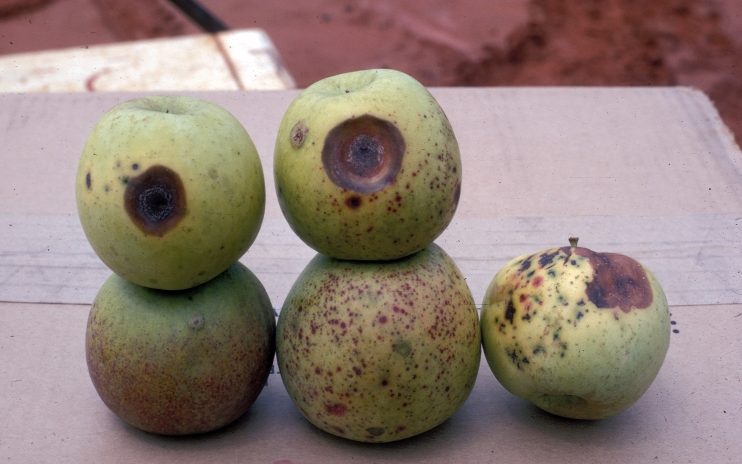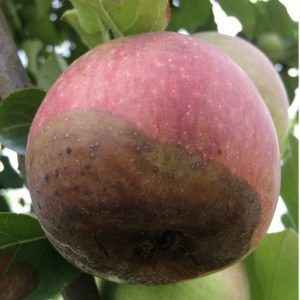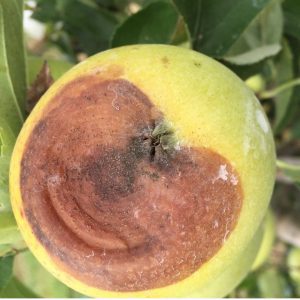Crop Production

The current rainy, hot, and humid summer conditions, combined with the approaching fruit crop maturity necessitate monitoring your apple or pear orchards for bitter rot symptom development on your fruit.
Causes of Bitter Rot
As an apple crop is growing well and sizing sweet and juicy fruit—small, sunken brown lesions, sometimes surrounded by a red halo can appear and are easily spotted on green or yellow fruit. These are the symptoms of bitter rot disease. Bitter rot is the most prominent summer fruit rot disease in the Southeast. In some seasons, it can cause losses approaching 100 percent in a few days.
Bitter rot on apple and pear fruit is caused by the pathogenic fungi Colletrotrichum gloeosporioides and C. acutatum. All apple cultivars grown in the Southeast are susceptible to bitter rot disease. The same causal pathogens are also responsible for anthracnose disease on peach, anthracnose fruit rot on blueberry and strawberry, ripe rot on grape, anthracnose on pepper, and blossom-end rot of green burrs on chestnuts. The discussion below is limited to the disease as it affects apple and pear trees.
- Bitter rot appears on the side of the side of the apple directly exposed to the sun.
- Bitter rot appears on the side of the side of the apple directly exposed to the sun.
Disease Symptoms
Bitter rot occurs on fruit. Cankers can form on twigs, but they are rare. The fungus is one of the few fruit rot organisms that can penetrate the unbroken skin of the fruit. Maturity of the fruit, temperature, humidity, and presence of disease are factors that determine when the disease manifests. Bitter rot typically manifests in July and August and fruit susceptibility increases as it begins to mature. The fungus does not require fruit wounding to establish an infection and can directly penetrate the fruit skin. Fruit infections can occur soon after bloom and appear as small, gray to brown flecks that may not enlarge until later in the summer. The most damaging fruit infections occur more than a month after petal fall. Rot spots usually appear on the side of the apple directly exposed to the sun. The disease is noticed first as a small, light brown, circular spot. One or many spots may appear; if temperature and humidity are high, they enlarge quite rapidly and soon change to a dark brown. By the time the spots are 1/8 to ¼ inch in diameter, they are distinctly sunken or saucer shaped. When they reach ½ inch in diameter, small black dots, the fruiting bodies of the fungus, appear in the sunken lesion. These may be arranged in concentric rings. Later, they ooze a gelatinous, salmon-pink mass of spores, washed by rains to other fruit. As the fruit ripens, it decays rapidly and finally shrivels into a mummy.
Disease Cycle
Bitter rot spores overwinter in mummified fruit, cracks and crevices in the bark, and cankers produced by either the bitter rot fungus or other diseases. Spores are produced during rainy periods in the spring and summer. Often the first infections appear as a cone-shaped area on the tree and can be traced to a source of spores at the tip of the cone. The optimal conditions for the disease to develop are rainfall, relative humidity of 80 to 100 percent, and a temperature of 80°F to 90°F.
Disease Management
To manage and control bitter rot in your orchard, remove old fire blight cankers and dead wood from your orchard. Alternatively, mulching the brush so it decays over the year also promotes sanitation. Remove apple mummies remaining on the tree from the previous season since the mummies serve as an inoculum source. Low areas of the orchard where drying is slower are susceptible areas. Bitter rot disease management is most effective by applying fungicides on a 10- to 14-day interval schedule through harvest and more frequently under favorable conditions. See the publication 2022 Integrated Orchard Management Guide for Commercial Apples in the Southeast for a list of recommended fungicides and spray schedules.



